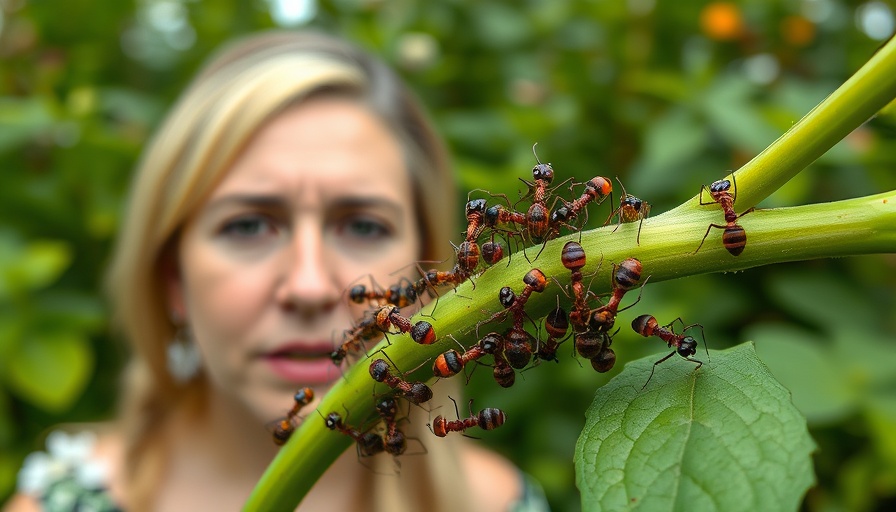
Understanding Diatomaceous Earth and Its Role in Gardening
For many gardeners in the Okanagan, diatomaceous earth (DE) has become a staple tool in the battle against pests. This white powder, made from crushed fossilized algae, is praised for its ability to control insect populations. But, does it live up to the hype? Let’s explore the science behind this substance to understand its efficacy and proper application.
In 'Why Diatomaceous Earth Might Be Useless (Unless You Do This),' the discussion dives into the effectiveness of diatomaceous earth for pest control, exploring key insights that sparked deeper analysis on our end.
The Science Behind Diatomaceous Earth
Diatomaceous earth consists primarily of silica, and its pest control mechanism is quite unique. It works by abrading the waxy exoskeletons of insects, dehydrating them as if they were being sandpapered. This means that rather than poisoning pests, diatomaceous earth kills by causing them to dry out, reminiscent of how the sun can affect sensitive skin.
However, the effectiveness of DE is highly situational. For instance, it excels at tackling soft-bodied garden pests like aphids and earwigs but falls short against harder exoskeletons typical in beetles. Moreover, it must be used under strict dry conditions—humidity significantly reduces its effectiveness. Gardeners should avoid applying diatomaceous earth post-rain or during humid weather, as moisture will render it ineffective.
Optimal Usage Tips for Okanagan Gardeners
For those keen on incorporating diatomaceous earth into their pest management strategies, proper application is key. First and foremost, it needs to remain dry; thus, placing it in areas with good airflow and sunlight is advisable. Targeting the undersides of leaves and the base of plants, particularly in dry weather, can enhance its performance considerably. When using DE, remember that it acts as a contact killer—it must come into direct contact with pests, meaning strategic placement is crucial.
When choosing diatomaceous earth, the brand and quality matter significantly. Not all diatomaceous earth is created equal—some types may contain particles that are less effective. The spiny, fresh texture of the right kind of DE is what makes it effective. Choosing food grade DE over pool grade is essential too, as pool grade can be toxic.
Environmental Considerations: The Pros and Cons
A significant benefit of diatomaceous earth is its potential impact on soil health. Once degraded, it releases monomeric silicon, which can aid in improving plant health by enhancing cell wall strength and disease resistance. This can translate to better nutrient cycling and organic material decomposition in the soil. However, it must be used judiciously to preserve beneficial microbe populations in the garden.
On the flip side, diatomaceous earth can also harm beneficial insects and organisms when misapplied. Gardeners must strike a balance between controlling pests and maintaining an ecosystem rich in beneficial organisms. Ensuring targeted application rather than blanket dusting helps protect these crucial components of a healthy garden.
Incorporating Diatomaceous Earth in Integrated Pest Management
Garden experts recommend using diatomaceous earth as part of an integrated pest management (IPM) strategy. This approach combines various methods—like companion planting and using organic sprays—alongside DE to create a more balanced ecosystem that is less reliant on any single pest control method. Relying solely on diatomaceous earth may yield mixed results, especially if conditions for its efficacy are not met.
Conclusion: The Bottom Line on Using Diatomaceous Earth
In conclusion, diatomaceous earth can be a powerful tool in pest management for Okanagan gardeners, but it is not a cure-all. Understanding its limitations and proper application methods can make all the difference. If you've had experiences with diatomaceous earth, the gardening community would love to hear your recommendations.
As we strive for sustainable gardening practices, consider the benefits and challenges presented by tools like diatomaceous earth. Join the conversation to share your thoughts and insights—your contribution can help fellow gardeners thrive!
 Add Row
Add Row  Add
Add 




 Add Row
Add Row  Add
Add 

Write A Comment